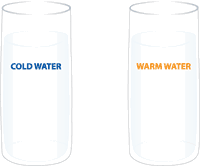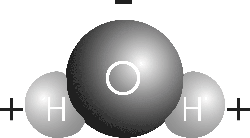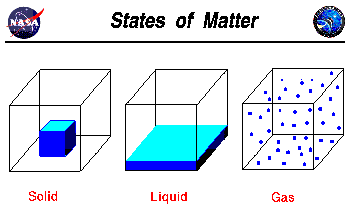Physics in your Glass: Racing Molecules
Have you ever come in from a day of sledding or ice skating and sat down for a drink of cold chocolate? Or had a glass of hot lemonade in the summer? Probably not. We use hot water for some things and cold water for others. Have you ever thought about what makes hot water hot and cold water cold?
 What you need
What you need
- Two glasses, about the same size
- 2 dark colors of food coloring
- Warm and cold water
What to do
- Put the two glasses next to each other. Pour cold water into one glass until it is about ¾ of the way full. Then pour warm water in the other glass up to the same level.
- Take a dropper of food coloring in each hand and add two drops of food coloring to each glass at the same time.
- Watch how the food coloring spreads through the glasses. Which glass does it spread through faster?
What’s going on?

A water molecule is made of a negatively charged oxygen atom and two positively charged hydrogen atoms.

Solids hold their shape even if you put them in a new container, liquids take the shape of the new container, and gases spreads out through the whole container. Image courtesy NASA.
You should notice the food coloring in the warm water spreading out faster than the food coloring in the cold water. If you didn’t observe this, try making your cold water a little colder and your warm water a little warmer. Also make sure you add the food coloring to each glass at the same time.
Water is made of molecules (two hydrogen atoms and one oxygen atom stuck together). Molecules in a liquid have enough energy to move around and pass each other. This is why water can flow and take the shape of the glass you pour it into. The molecules in solids, like ice, don’t have enough energy to move around very much so the solid keeps its shape. Molecules in a gas have lots of energy and spread out even more than molecules in a liquid.
Warm water has more energy than cold water, which means that molecules in warm water move faster than molecules in cold water. The food coloring you add to the water is pushed around by the water molecules. Since the molecules in warm water move around faster, the food coloring spreads out quicker in the warm water than in the cold water.
Try this
- Repeat this experiment with vegetable oil instead of water. Does this affect the results?
- Repeat this experiment but instead of using the same liquid at two different temperatures, use two different liquids at the same temperature (such as oil and water). What does this tell you about how easily the molecules in water move versus the molecules in oil?
- Try adding soap to the glasses – does it make a difference? What about adding salt?
To find out more
- Chemical Engineering and News: Food Coloring – Synthetic and natural additives impart a rainbow of possibilities to the foods we eat
- Harcourt School Publishers: States of Matter (Nice animation!)
- Purdue, Department of Chemistry: What is a Liquid? (Use the navigation on the left to go through the “Introduction” slides)
- Sweet Briar College: The Chemistry of Water – Structure Means Function











